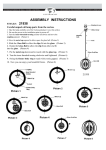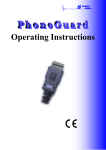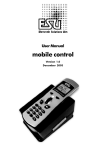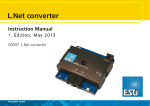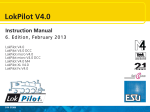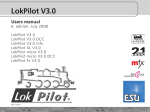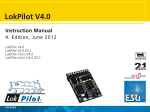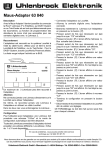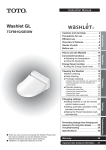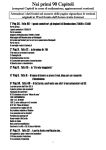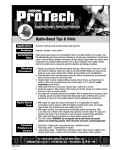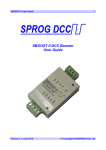Download User`s Manual - Euro Rail Hobbies & More
Transcript
The Multiprotocol Power System User’s Manual Authors: Dr.-Ing. T. Vaupel, M. Berger Translation: H. Schäfer © Copyright Uhlenbrock Elektronik GmbH, Bottrop 2nd edition, June 2003 All rights reserved. Reproduction - even partial - only under authorization. Order number 60 562 Power 3 Contents 1. General 1.1 Description 1.2 Technical data 4 4 2. Setup 2.1 2.2 2.3 2.4 2.5 2.6 2.7 Connector definition Plug wiring Hookup of transformer, track, and return-loop Connection to the Central Unit Connection to a DCC Central Unit Adding more boosters Selection of operating mode 5 5 6 6 7 7 7 3. Booster 3.1 3.2 3.3 3.4 Description Selection of control input connector Output voltage limiting DCC-operation without feedback to the Central Unit 8 8 8 9 4. Automatic return-loop handling 4.1 Description 4.2 Activation of return-loop handling 4.3 Hookup 10 10 10 5. Brake generator 5.1 5.2 5.3 5.4 5.5 Description Selection of control input connector Selection of operating mode Connection Brake generator operation without connection to a Central Unit 6. Error indications 12 12 12 12 13 14 All brand names used are registered trademarks of the respective companies. 3 Power 3 1. General 1.1 Description Power 3 is a short-circuit-proof 3-ampere booster capable of handling different data transfer formats. It features a selectable automatic return-loop handling, and its operation mode may be changed over to work as a NMRA-compatible DCC brake generator. The device is compatible with Central Units of Uhlenbrock, Arnold, Lenz, and Märklin. 1.2 Technical data Maximal input voltage 18 V AC Maximal track current 3 amperes All outputs are short-circuit proof. Dimensions 180 x 136 x 80 mm (7 1/8 x 5 3/8 x 3 3/16 inches) Required transformer capacity 52 - 70 VA 4 Power 3 2. Setup In the following, the connectors of Power 3 are described together with the necessary hookup instructions 2.1 Connector defintion Pict. 2.11 Rear side showing all connectors 2 1 2 3 4 5 3 4 6-pole male connector: 5-pole male connector: 5-pole male connector: 3-pole male connector: 4-pole DIP switch: 5 1 Transformer, track, return loop Next booster or Central Unit Next booster or Central Unit DCC Central Unit Operation mode 2.2 Plug wiring The device comes with two plugs for connection of transformer, track, return loop, and DCC Central Unit. Pict.2.21 The necessary wires have to be Rear side showing inserted into their spring-loaded all connectors terminals. The terminal identfiers are shown on the picture beside. Pict. 2.22 Plug terminal identifiers The leads have to be made from either solid or stranded wire of 0,25 mm2 (AWG 23/SWG 24). Insulation must be stripped off for 6 mm (¼ in) at the end. Stranded wire must either be twisted or tinned. Use a small screwdriver of 2 mm (0.08 in), insert it in the upper opening and push down the spring slightly. Slide the stripped end of the lead into the terminal. Release the screwdriver and the wire will be held firmly in position. 5 Power 3 2.3 Hookup of transformer and track Transformer, track, and return-loop are all hooked up to connector #1. The plug terminals are designated as follows: 123456 yellow brown 16V~ Pict. 2.31 6-pole plug terminal designations brown red return-loop brown red 1 2 3 4 5 return-loop return-loop track feeder N digital (Märklin red) track feeder S digital (Märklin brown) 16 V AC input - common (Märklin brown) 6 16 V AC input - phase (Märklin yellow) track Transformer requirements For trouble-free operation, the transformer must be able to supply 52 VA at 16 VAC minimally. Under full load, we recommend a 70 VA transformer such as the Uhlenbrock type 20 070. The voltage should not exceed 18 VAC. The transformer must be connected to the terminals #5 (brown) and #6 (yellow) of the plug. Pict. 2.32 2-rail hookup Pict. 2.33 3-rail hookup 2-rail track 2-rail track is connected to terminals #3 and #4 of the plug. 3-rail track 3-rail track (Märklin) is connected by inserting the brown lead into terminal #4 and the red lead (center conductor) into terminal #3. 2.4 Connection to the Central Unit Either Intellibox or Märklin Central Unit may be used. Electrical connection is achieved by a ribbon-cable supplied with Power 3. Connector 2 of booster is linked to connector 5 of the Intellibox or the booster connector of the Märklin Central Unit. Pict. 2.41 Way of connecting the ribbon-cable with booster and different Central Units Power 3 Intellibox or M 6021 Power 3 M 6020 The plugs have to be oriented upwards for Uhlenbrock devices and M 6021, and downwards for M 6020. 6 Power 3 2.5 Connection to a DCC Central Unit Connector 4 is used for DCC input. It is also possible to use the booster in connection with a Lenz LZ100 Central Unit or an Arnold 86200 Central Unit. Pict. 2.51 3-pole plug terminal assignments 1 C = Signal N 2 D = Signal S 3 E = Short circuit indication 2.6 Adding more boosters Connector 3 is used for connecting another Power 3 or Märklin boosters 6015 or 6017. Pict. 2.61 Way of connecting the ribbon-cable with Power 3 and different boosters Power 3 or M 6017 Power 3 M 6015 Power 3 The plugs have to be oriented upwards for Uhlenbrock devices and M 6017, and downwards for M 6015. 2.7 Selection of operating mode Dip-switch 5 selects the different operating modes of the device. 1 2 3 4 Input selector Intellibox-Märklin or DCC Brake generator mode on/off Automatic return-loop handling on/off Voltage limit on/off Power 3 DIP-switch setting ON OFF 1 2 3 4 DIP-switch no. 1 2 3 Motorola input OFF DCC input ON Booster without return-loop OFF OFF Booster with return-loop OFF ON Break generator mode ON OFF 4 Voltage limit (H0 and bigger) OFF Voltage limit max. 18 V (N) ON 7 Power 3 3. Booster 3.1 Description Power 3 delivers a current of 3 amperes. The output is short-circuit proof. The device can be used in conjunction with different digital Central Units. When used with an Intellibox, it will deliver Motorola, DCC, and Selectrix data formats to the track. When used with a Märklin, Lenz, or Arnold Central Unit it will transfer the data format supplied by these. It is not possible to operate the device together with a Selectrix Central Unit. 3.2 Selection of control input connector Power 3 may work on input provided by Motorola- or DCC Central Units. Depending on the data format, these Central Units are jacked to different connectors. The DIP-switch on the rear side of the device must be set accordingly. Pict. 3.21 DIP-switch of Power 3 ON OFF 1 2 3 4 Switch 1 OFF - when the device is connected to an Intellibox or a Märklin Central Unit via connector 2. Switch 1 ON - when the device is connected to a DCC Central Unit (Lenz LZ100, Arnold 86200) via connector 4. 3.3 Output voltage limiting The output voltage depends on the transformer used and the load present. A standard 16 V AC transformer delivers a no-load peak voltage of 22 V. As this is too high for the smaller scales, it can be limited to a peak value of 18 V for e.g. N scale. Switch 4 OFF - no output voltage limit Switch 4 ON - the peak voltage is limited to 18V 8 Power 3 3.4 DCC-operation without feedback to the Central Unit If a booster is feeding a track sector and the short-circuit feedback to the Central Unit is not desired, this booster must be connected by the DCC-input. Only C and D terminals are used (refer to connection of a DCC Central Unit) In case of a short, the booster will cut the track power for 10 seconds. If the short-circuit continues, it will cut it out for 10 seconds again. IMPORTANT If this mode is used in conjunction with an Intellibox, Selectrix decoders cannot be operated in the sectors fed by this booster. 9 Power 3 4. Automatic return-loop handling 4.1 Description When using 2-rail track, a return loop will always create a shortcircuit and the booster will shut down. This is valid for analog and for digital operation. A gapped sector within the loop eliminates this condition. It has to have its special supply so that a vehicle can go through the loop without difficulty. Power 3 offers such a supply module with isolated outputs for 2rail operation (DCC, Märklin Gauge 1, Selectrix). Any number of return-loops may be connected to it subject to the limitation that only one can be crossed by a vehicle at a time. 4.2 Activation of return-loop handling The DIP-switches on the rear of Power 3 must be set for ‘booster with return-loop handling‘ mode. Switch 3 ON - activate return-loop handling Switch 2 OFF - deactivate brake generator mode IMPORTANT When handling return-loops, brake-generator mode must be off. 4.3 Connection The return-loop is fed by a 6-pole plug attached to connector 1 of Power 3. Refer to the following schematic showing the loop track connected to terminals 1 and 2, and the normal track(s) connected to terminals 3 (red) and 4 (brown). 123456 16V~ Loop track Normal track Pict. 4.31 Connection of a return-loop CAUTION Both rails of the loop track must be gapped! 10 Power 3 IMPORTANT Tracks immediately adjacent to the return-loop must be fed by the booster that controls the loop. As the loop control is activated by a vehicle crossing the gaps, feeders from the booster running to loop and normal trackage should be placed close to them. 11 Power 3 5. Break generator 5.1 Description A brake generator takes care of the prototypical deceleration of DCC-locos in front of a signal showing ‘danger’. The loco will slow down according to the rate set in its decoder CV. A particular ‘brake’ signal triggers this action. Moreover, a special circuitry has to avoid short circuits between the braking section and the remainder of the track when a vehicle crosses the gap. The brake generator monitors every individual braking section. As soon as a train is completely within the section, the brake generator takes over. 5.2 Selection of control input connector The Power 3’s data signal may derive from a Motorola- or a DCC Central Unit. They are connected to different inputs depending on the data format. Moreover, the DIP-switch on the booster’s rear side must reflect this selection. Switch 1 OFF - when the device is connected to an Intellibox or a Märklin Central Unit via connector 2. Switch 1 ON - when the device is connected to a DCC Central Unit (Lenz LZ100, Arnold 86200) via connector 4. 5.3 Selection of operating mode In order to use the Power 3 as a brake generator, the DIP-switches on the rear side must be set accordingly. Switch 2 ON - Brake generator mode on Switch 3 OFF - Booster mode off 5.4 Connection A section in front of a distant signal is subdivided into a running and a braking sector. They are switched over to brake generator operation by an occupancy detector as soon as the train enters the braking sector. Therefore, the running sector must be made a trifle longer than the longest train in order to avoid shorts. The length of the braking sector must be chosen in such a way that all locos with a set deceleration will come to a full stop within. The changeover to braking can be achieved e.g. by occupancy detector with relay, item #43 400. The power supply can be provided by the Intellibox’s booster, another Power 3 (item # 65 600), or a Märklin booster (6015 or 6017). 12 Power 3 S1 Direction of travel Central Unit or booster Pict. 5.41 Possible circuit employing a GBM occupancy detector Break generator running sector block section Relay 2 Relay 1 AC Track supply +/- Monitored section Track supply / AC Switch S1 must be a NC type. It may be taken from the block signal or a relay contact. Switching the signal to ‘proceed’ must open S1, so that the occupancy detector (GBM) is not activated. The whole block section is fed by a Central Unit or a booster in this case. When the signal is set to ‘danger’, S1 closes and the occupancy detector (e.g. GBM 43400) monitors the braking sector. As soon as a vehicle enters it, the whole block section’s supply will be taken over by the brake generator. 5.5 Brake generator operation without connection to a Central Unit If the booster is used as a braking generator without short-circuit feedback and control by the Central Unit, the operation mode has to be set to brake generator and Motorola input. A cable connection to the Central Unit is not needed in this case. In case of a short, the booster will cut the track power for 10 seconds. If the short-circuit continues, it will cut it out for 10 seconds again. The braking sector cannot be switched off by the Central Unit. 13 Power 3 6. Error indications Power 3 indicates errors and failures by different blinking sequences of the red and green LEDs. green LED on - red LED off ’go’-key depressed Track voltage present (normal operation) red LED on - green LED off ’stop’-key depressed Track voltage cut by the Central Unit green LED off - red LED flashing Short circuit indication LEDs flash alternatively red and green Overheating, track voltage is off LEDs flash alternatively one time red and two times green No data input signal present LEDs flash alternatively one time red and three times green External voltage present at outputs when Power 3 is switched on 14 Power 3 HOTLINE Any problems? Please e-mail to [email protected] 15















